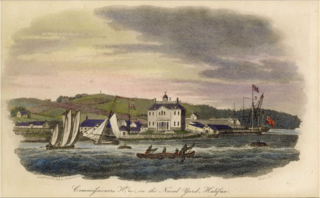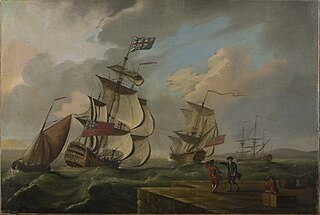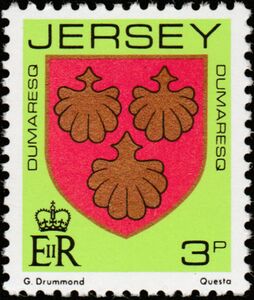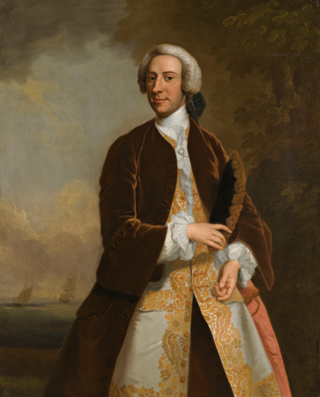
Royal Naval Dockyard, Halifax was a Royal Navy base in Halifax, Nova Scotia. Established in 1759, the Halifax Yard served as the headquarters for the Royal Navy's North American Station for sixty years, starting with the Seven Years' War. The Royal Navy continued to operate the station until it was closed in 1905. The station was sold to Canada in 1907 becoming Her Majesty's Canadian Dockyard, a function it still serves today as part of CFB Halifax.

HMS Kent was a 70-gun third rate ship of the line built by Sir Henry Johnson of Blackwall in 1677/79. She served during the War of English Succession 1699 to 1697, participating in the Battle of Barfleur. She was rebuilt in 1697/99. She served during the War of Spanish Succession 1702 to 1712 and partook in the Battles of Vigo and Velez-Malaga. She partook in the Battle of Passaro then served during the short war with Spain, December 1718 to February 1720. She was rebuilt in 1722/26. She spent the next thirteen years as a guard ship at Portsmouth. In the 1740s she was off Cape Finisterre then in the West Indies. She returned home and was finally broken in 1744.

John Rous was a Royal Navy officer and privateer. He served during King George's War and the French and Indian War. Rous was also the senior naval officer on the Nova Scotia station during Father Le Loutre's War. Rous' daughter Mary married Richard Bulkeley and is buried in the Old Burying Ground in Halifax, Nova Scotia.

HMS Princess was a 70-gun third rate ship of the line of the Royal Navy. She had served for ten years as the Princesa for the Spanish Navy, until her capture off Cape Finisterre in 1740 during the War of the Austrian Succession.

The action of 8 April 1740 was a battle between the Spanish third rate Princesa under the command of Don Parlo Augustino de Gera, and a squadron consisting of three British 70-gun third rates; HMS Kent, HMS Lenox and HMS Orford, under the command of Captain Colvill Mayne of Lenox. The Spanish ship was chased down and captured by the three British ships, after which she was acquired for service by the Royal Navy.

The Battle off Halifax took place on 28 May 1782 during the American Revolutionary War. It involved the American privateer Jack and the 14-gun Royal Naval brig HMS Observer off Halifax, Nova Scotia. Captain David Ropes commanded Jack, and Lieutenant John Crymes commanded Observer. The battle was "a long and severe engagement" in which Captain David Ropes was killed.
Captain Sir Rupert George, 1st Baronet was a British naval officer in the American Revolution, became the Commodore for the Royal Navy's North America Station (1792-1794). He then returned to England and became the first Commissioner of the Transport Service, where he stayed for 22 years.

Lord Augustus FitzRoy was a British officer of the Royal Navy. He served during the War of the Austrian Succession, and was involved in the capture of the Spanish ship of the line, Princesa, a major prize in the war. He was also the father of Augustus FitzRoy, 3rd Duke of Grafton, who became Prime Minister of Great Britain.

Lieutenant-General Peregrine Lascelles (1685–1772), also spelt Lascells, was a British military officer from Yorkshire.
HMS Winchelsea was a 20-gun sixth-rate launched in 1740 and in service during the War of the Austrian Succession in Mediterranean, Atlantic and home waters. She was captured by the French in 1758, but was retaken two weeks later. She was broken up in 1761.

The Dumaresq family was a patrician family in the Channel Islands with a particularly strong presence in Jersey. The family would hold many offices and positions throughout the history of Jersey from the 13th century.

Admiral Thomas Dumaresq was an officer in the British Royal Navy that rose to the rank of Admiral. Dumaresq was notable for his role as Captain of HMS Repulse in the Battle of the Saintes during the American Revolutionary War.
Admiral Salmon Morrice was a Royal Navy officer and Vice-admiral of the White.

Vice-Admiral Alexander Fraser (1747–1829) was a late 18th century and early 19th century Royal Navy commander during the Napoleonic Wars. He was responsible for the landing parties in the Battle of Long Island, captured several privateers and took place in the Second Battle of Copenhagen.

HMS Success was a 20-gun Royal Navy ship launched in 1740 as the first government contract for the Blaydes Yard in Hull. She had a crew of 140 men. She had several famous commanders over her lifetime.
Admiral George Ourry Lempriere (1787-1864) was an officer in the British Royal Navy during the Napoleonic Wars that rose to the rank of Admiral.

Captain Philip de Saumarez (1710–1747) was a British naval officer, notable for his role as captain of HMS Nottingham in capturing the French ship Mars and as the first lieutenant of George Anson,1st Baron Anson in his voyage around the world. He designed what would eventually be the first uniforms for the Royal Navy.

Elias Dumaresq, 3rd Seigneur of Augrès was born to Abraham Dumaresq, 2nd Seigneur of Augrès and Susan de Carteret daughter of Philippe de Carteret I, 2nd Seigneur of Sark and his wife Racheal Paulet. He was a Royalist and a Jurat of the Royal Court.
Captain Lancelot Skynner was an 18th century Royal Navy commander. He was drowned at the sinking of the infamous HMS Lutine famed for the ship's bell: the Lutine Bell.

Thomas Collingwood was a British Royal Navy commander, who served on HMS Fortune, HMS Siren, and HMS Jersey, among others. Collingwood played an important role in the Battle of Grenada and the Battle of Martinique (1780).















